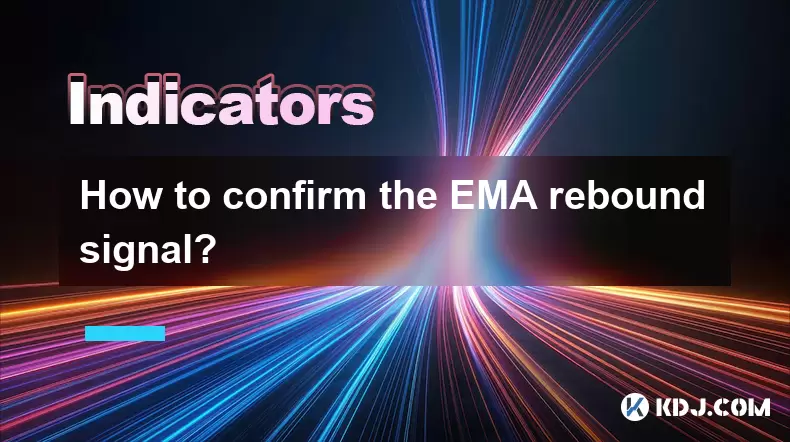-
 bitcoin
bitcoin $114320.977035 USD
-0.40% -
 ethereum
ethereum $4152.439985 USD
-1.75% -
 tether
tether $1.000111 USD
-0.04% -
 xrp
xrp $2.843037 USD
-1.63% -
 bnb
bnb $1013.349380 USD
-1.62% -
 solana
solana $208.362767 USD
-2.10% -
 usd-coin
usd-coin $0.999783 USD
0.00% -
 dogecoin
dogecoin $0.232559 USD
-1.00% -
 tron
tron $0.333491 USD
-1.09% -
 cardano
cardano $0.806310 USD
0.19% -
 hyperliquid
hyperliquid $45.023720 USD
-1.59% -
 ethena-usde
ethena-usde $1.000819 USD
-0.06% -
 chainlink
chainlink $21.241249 USD
-2.11% -
 avalanche
avalanche $30.035416 USD
-0.66% -
 stellar
stellar $0.364984 USD
-2.05%
How to confirm the EMA rebound signal?
To confirm an EMA rebound signal, look for increased volume, bullish candlestick patterns, and supporting indicators like RSI and MACD for a stronger trading decision.
May 22, 2025 at 07:35 am

Introduction to EMA and Rebound Signals
The Exponential Moving Average (EMA) is a popular technical indicator used by traders to identify trends and potential reversal points in the cryptocurrency market. A rebound signal occurs when the price of a cryptocurrency bounces off an EMA line, suggesting a potential change in the current trend. Understanding how to confirm an EMA rebound signal is crucial for making informed trading decisions. This article will guide you through the process of confirming an EMA rebound signal, ensuring you can leverage this information effectively.
Setting Up Your Trading Chart
Before you can confirm an EMA rebound signal, you need to set up your trading chart correctly. Most trading platforms offer customizable charts where you can add various indicators.
- Open your trading platform and navigate to the chart section.
- Select the cryptocurrency pair you wish to analyze.
- Add the EMA indicator to your chart. You can usually find this under a section labeled 'Indicators' or 'Studies.'
- Choose the time periods for the EMAs. Common settings are the 9-day, 21-day, and 50-day EMAs, but you can adjust these based on your trading strategy.
- Adjust the chart time frame according to your trading style. Shorter time frames like 15 minutes or 1 hour are suitable for day trading, while longer time frames like daily or weekly charts are better for swing trading.
Identifying the EMA Rebound
Once your chart is set up, the next step is to identify a potential EMA rebound. A rebound occurs when the price touches or crosses an EMA line and then moves in the opposite direction.
- Monitor the price action as it approaches the EMA line. If the price touches the EMA and then reverses, this could be an early sign of a rebound.
- Look for a clear bounce off the EMA. The more decisive the bounce, the stronger the potential signal.
- Check multiple EMAs. If the price rebounds off multiple EMAs (e.g., both the 21-day and 50-day EMAs), it strengthens the signal.
Confirming the Rebound Signal
Confirming an EMA rebound signal involves looking for additional indicators and patterns that support the initial signal. Here are some steps to confirm the rebound:
- Use volume indicators. A spike in trading volume during the rebound can confirm the signal, indicating strong market interest.
- Check for candlestick patterns. Bullish candlestick patterns like hammers or engulfing patterns near the EMA can reinforce the rebound signal.
- Look for support and resistance levels. If the EMA coincides with a known support or resistance level, it adds credibility to the rebound signal.
- Analyze other technical indicators. Indicators like the Relative Strength Index (RSI) or the Moving Average Convergence Divergence (MACD) can provide additional confirmation. For instance, an RSI moving out of the oversold region or a bullish crossover in the MACD can support the rebound signal.
Practical Example of Confirming an EMA Rebound
Let's walk through a practical example to illustrate how to confirm an EMA rebound signal.
- Scenario: You are analyzing the Bitcoin/USD pair on a 1-hour chart with the 21-day and 50-day EMAs added.
- Observation: The price of Bitcoin drops to touch the 21-day EMA and then bounces upwards.
- Step 1: Check the volume. You notice a significant increase in trading volume during the bounce, indicating strong market interest.
- Step 2: Examine candlestick patterns. You see a bullish engulfing pattern at the point of the bounce, further supporting the rebound.
- Step 3: Look at support levels. The 21-day EMA is near a known support level, adding to the credibility of the signal.
- Step 4: Analyze other indicators. The RSI is moving out of the oversold region, and the MACD shows a bullish crossover. Both of these additional indicators confirm the EMA rebound signal.
Common Mistakes to Avoid
While confirming an EMA rebound signal, it's important to be aware of common pitfalls that can lead to misinterpretation.
- Ignoring volume. A rebound without a corresponding increase in volume may be a false signal.
- Overlooking other indicators. Relying solely on the EMA without considering other technical indicators can lead to inaccurate confirmations.
- Misjudging the strength of the bounce. A weak bounce off the EMA might not be a reliable signal.
- Failing to consider the broader market context. The overall market trend and sentiment can significantly impact the validity of an EMA rebound signal.
Frequently Asked Questions
Q1: Can EMA rebound signals be used for all cryptocurrencies?Yes, EMA rebound signals can be applied to any cryptocurrency, but their effectiveness may vary depending on the liquidity and volatility of the specific asset. More liquid assets like Bitcoin and Ethereum tend to produce more reliable signals.
Q2: How often should I check for EMA rebound signals?The frequency of checking for EMA rebound signals depends on your trading strategy. For day traders, checking every few hours or even more frequently on shorter time frames can be beneficial. Swing traders might check daily or weekly charts less frequently.
Q3: Are EMA rebound signals more effective on certain time frames?EMA rebound signals can be effective on various time frames, but they tend to be more reliable on longer time frames such as daily or weekly charts. This is because longer time frames filter out short-term noise and provide clearer trend signals.
Q4: Can I use EMA rebound signals in conjunction with other trading strategies?Absolutely. EMA rebound signals can be integrated with other trading strategies, such as trend following or mean reversion strategies, to enhance your overall trading approach. Combining multiple indicators and strategies can help increase the accuracy of your trading decisions.
Disclaimer:info@kdj.com
The information provided is not trading advice. kdj.com does not assume any responsibility for any investments made based on the information provided in this article. Cryptocurrencies are highly volatile and it is highly recommended that you invest with caution after thorough research!
If you believe that the content used on this website infringes your copyright, please contact us immediately (info@kdj.com) and we will delete it promptly.
- BlockDAG, DOGE, HYPE Sponsorship: Crypto Trends Shaping 2025
- 2025-10-01 00:25:13
- Deutsche Börse and Circle: A StableCoin Adoption Powerhouse in Europe
- 2025-10-01 00:25:13
- BlockDAG's Presale Buzz: Is It the Crypto to Watch in October 2025?
- 2025-10-01 00:30:13
- Bitcoin, Crypto, and IQ: When Genius Meets Digital Gold?
- 2025-10-01 00:30:13
- Stablecoins, American Innovation, and Wallet Tokens: The Next Frontier
- 2025-10-01 00:35:12
- NBU, Coins, and Crypto in Ukraine: A New Yorker's Take
- 2025-10-01 00:45:14
Related knowledge

What is a tower bottom candlestick pattern? Does it have a high success rate?
Sep 22,2025 at 07:18am
Tower Bottom Candlestick Pattern Explained1. The tower bottom candlestick pattern is a reversal formation that typically appears at the end of a downt...

What is a black hole pattern in the MACD indicator? Is it a cause for concern?
Sep 21,2025 at 06:54pm
Bitcoin's Role in Decentralized Finance1. Bitcoin remains the cornerstone of decentralized finance, serving as a benchmark for value and security acro...

How can I use the psychological line (PSY) to determine market sentiment?
Sep 17,2025 at 02:19pm
Understanding the Psychological Line (PSY) in Cryptocurrency TradingThe Psychological Line, commonly referred to as PSY, is a momentum oscillator used...

How can I determine if a double top pattern has officially formed?
Sep 21,2025 at 03:18am
Understanding the Structure of a Double Top Pattern1. A double top pattern consists of two distinct peaks that reach approximately the same price leve...

What is the Golden Valley pattern on the moving average? Is it better than the Silver Valley pattern?
Sep 21,2025 at 02:54pm
Understanding the Golden Valley Pattern in Moving Averages1. The Golden Valley pattern is a technical formation observed in cryptocurrency price chart...

What does a death cross of the RSI in the strong zone (above 50) mean?
Sep 17,2025 at 10:54pm
Understanding the Death Cross in RSI Context1. The term 'death cross' is traditionally associated with moving averages, where a short-term average cro...

What is a tower bottom candlestick pattern? Does it have a high success rate?
Sep 22,2025 at 07:18am
Tower Bottom Candlestick Pattern Explained1. The tower bottom candlestick pattern is a reversal formation that typically appears at the end of a downt...

What is a black hole pattern in the MACD indicator? Is it a cause for concern?
Sep 21,2025 at 06:54pm
Bitcoin's Role in Decentralized Finance1. Bitcoin remains the cornerstone of decentralized finance, serving as a benchmark for value and security acro...

How can I use the psychological line (PSY) to determine market sentiment?
Sep 17,2025 at 02:19pm
Understanding the Psychological Line (PSY) in Cryptocurrency TradingThe Psychological Line, commonly referred to as PSY, is a momentum oscillator used...

How can I determine if a double top pattern has officially formed?
Sep 21,2025 at 03:18am
Understanding the Structure of a Double Top Pattern1. A double top pattern consists of two distinct peaks that reach approximately the same price leve...

What is the Golden Valley pattern on the moving average? Is it better than the Silver Valley pattern?
Sep 21,2025 at 02:54pm
Understanding the Golden Valley Pattern in Moving Averages1. The Golden Valley pattern is a technical formation observed in cryptocurrency price chart...

What does a death cross of the RSI in the strong zone (above 50) mean?
Sep 17,2025 at 10:54pm
Understanding the Death Cross in RSI Context1. The term 'death cross' is traditionally associated with moving averages, where a short-term average cro...
See all articles










































































